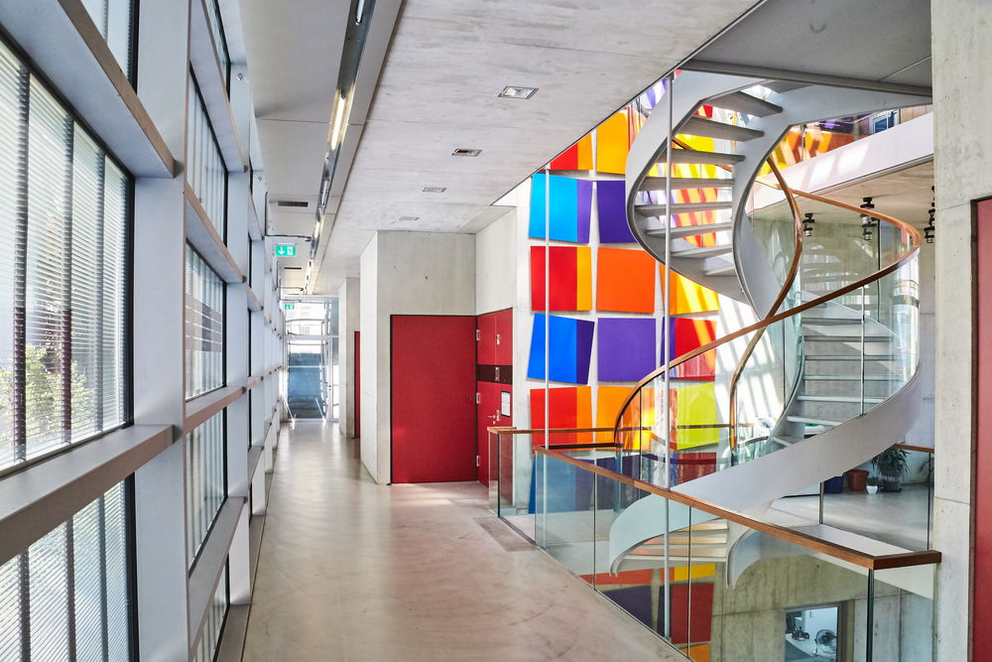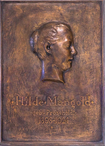The laboratory building Hilde Mangold Haus provides the Cluster of Excellence CIBSS - Centre for Integrative Biological Signalling Studies with excellent infrastructures for projects in signaling research. Together with the nearby Signalhaus, it is a central component of the "Signalling Campus", a facility that underlines the importance and innovative power of signalling research at the University of Freiburg, providing scientists with concrete space for research and exchange.


Hilde Mangold Haus

Inside the Hilde Mangold Haus
Image: Harald Neumann/Universität Freiburg
Origin of the building name
Dr. Hilde Mangold, née Pröscholdt, conducted research in the early 1920s as a doctoral student of Prof. Dr. Hans Spemann in Freiburg. She is well known in developmental biology for her methodologically sophisticated and pioneering transplantation experiments on amphibian embryos. With this work, which followed on from Spemann's earlier experiments, she was able to show that there is a specific "organizer" region in the embryo that controls the formation of the body axis with spine, spinal cord, head and tail. Later, the term Spemann-Mangold organizer (often just Spemann organizer) was coined for this region. Hans Spemann received the Nobel Prize in Physiology and Medicine in 1935 for his discovery of the organizer effect. It is unclear whether Hilde Mangold would also have received this prize, as she was killed in an accident years earlier. The naming of the research building commemorates her extraordinary work, crucial for embryology and signalling science in general.
Publication about Hilde Mangold, Hans Spemann and the "Organizer" by Klaus Sander and Peter Fässler from 2001
More Information on Hilde Mangold
"Hilde Mangold: a Pioneer of Signalling Research" by Michal Rössler & Mathilde Bessert-Nettelbeck
MoreBrief history of the Hilde Mangold Haus
The HMH was formerly known as the ZBSA Zentrum für Biosystemanalyse. After being dedicated to CIBSS in 2020 the building was renamed in recognition of the work by young scientist Hilde Mangold in 2021
History of the ZBSA / HMH
Classen Lab
Our research aims to understand how cells cooperate to heal wounds, to regenerate tissues or to eliminate tumorigenic cells. We specifically focus on epithelial tissues, as they act as surface linings and barriers for many of the major organs. Our favourite model system, the fruit fly Drosophila, has a number of epithelial tissues we use to address these important questions.
Classen LabCore Facility Life Imaging Center (LIC)
The LIC has a major focus on live cell imaging of all kind of cells, organisms and culture systems used in cell signaling research, developmental biology and neurobiology. It operates 21 confocal, superresolution, wide field and screening microscopes for FRET, FRAP, FLIP, FLAP, photoconversion, uncaging, spectral unmixing, TIRF and structured illumination.
Life Imaging CenterHartman Lab
The research in our laboratory focuses on how environmental signals control plant stress responses and development. We mainly study how plants sense and acclimate to flooding stress, which is a large problem in agriculture. We aim to uncover how plants encode flooding stress memory, and to identify the molecular targets that lead to improved flooding tolerance.
Hartman LabPyrowolakis Lab
The lab investigates intercellular signaling during organ and animal development and homeostasis. We are using Drosophila BMP signaling as a paradigm to understand how signaling gradients (morphogens) are established, maintained and interpreted during epithelial patterning and morphogenesis. In addition, we are interested in the extracellular regulation of BMP signaling in the context of germline stem cell maintenance and differentiation.
Pyrowolaski Lab




